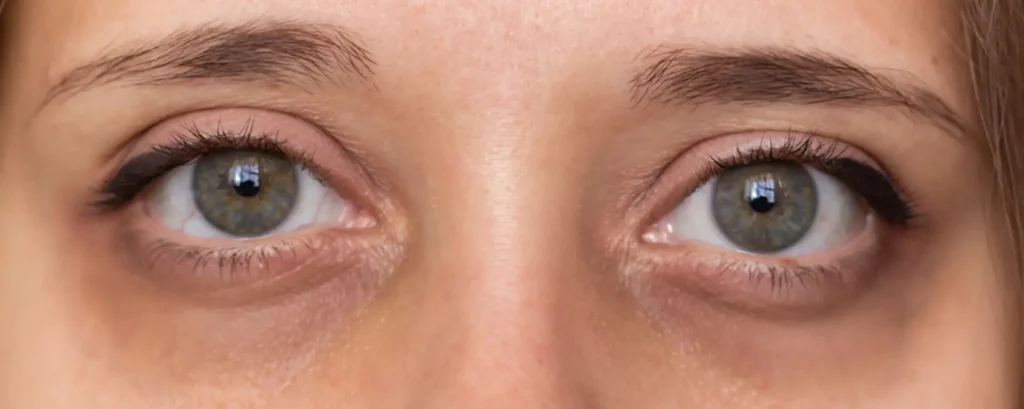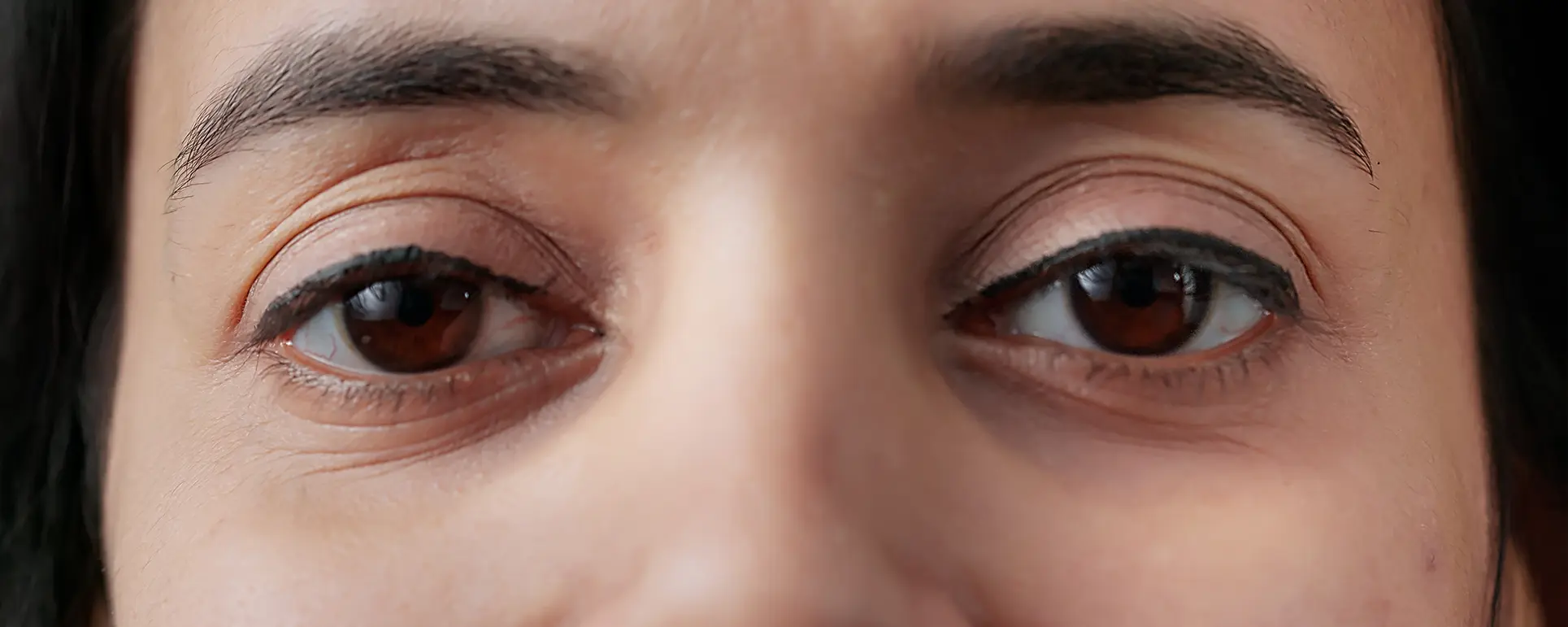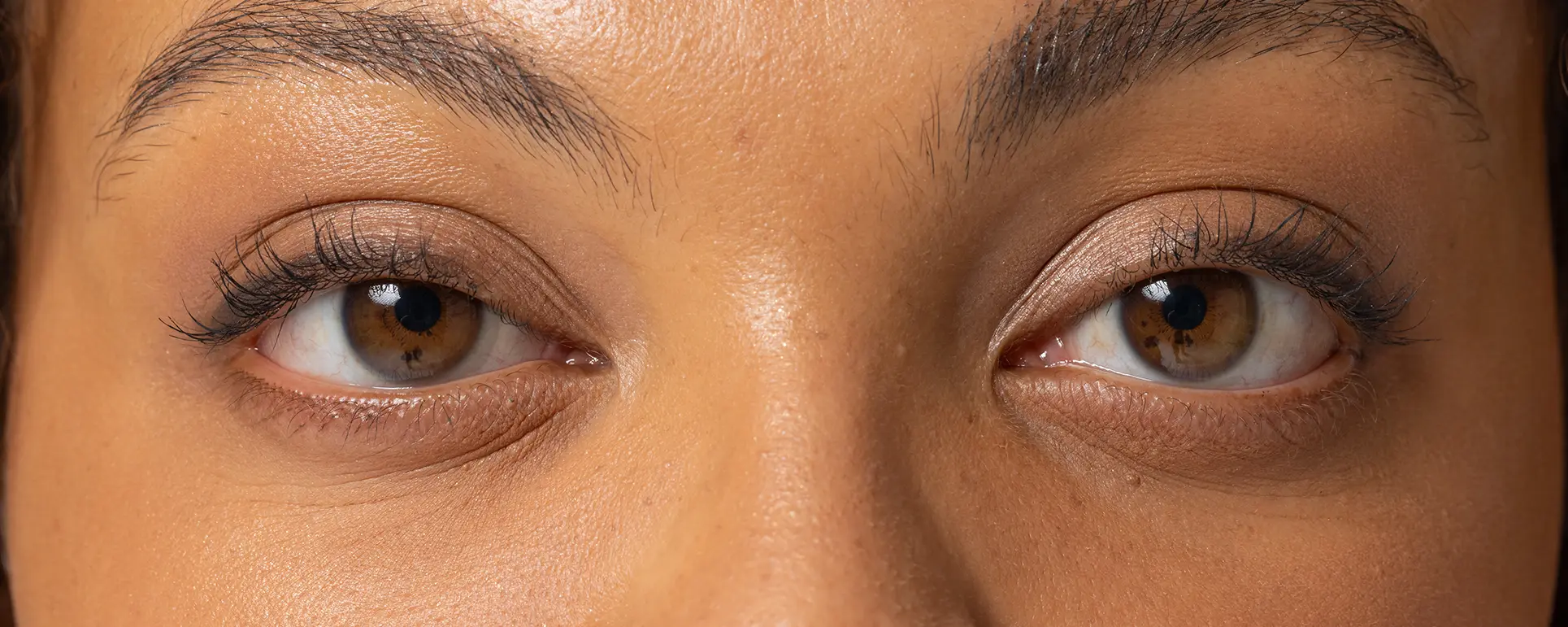If you’ve noticed dark circles under your eyes, it’s natural to feel concerned. After all, they can make you look constantly tired, older, or unwell. One common explanation you might have heard is that dark circles are linked to liver problems. This can be worrying, especially if you’re otherwise feeling healthy.
The truth is more nuanced. While the liver plays a crucial role in filtering toxins and supporting overall health, dark circles are rarely a direct indicator of liver disease. In most cases, their appearance is influenced by far more common factors, such as genetics, skin structure, ageing, lifestyle habits, and environmental factors. Lack of sleep, dehydration, stress, poor diet, and allergies can all contribute to the shadowy hollows or pigmentation under the eyes.
Understanding the real causes is essential for managing dark circles effectively. By separating myth from fact, you can make informed decisions about skincare, lifestyle adjustments, and whether you need professional advice. In this article, we’ll explore the science behind dark circles, examine the role (or lack thereof) of liver health, and highlight the situations when it’s worth consulting a medical professional. With this knowledge, you can approach the issue confidently rather than relying on myths or misinformation.
It’s also important to recognise that dark circles are rarely caused by a single factor. Often, they result from a combination of influences, such as thin under-eye skin that reveals underlying blood vessels, natural pigmentation differences, or chronic eye strain. This complexity means that treatment approaches may vary widely, from simple lifestyle changes and topical products to more advanced dermatological procedures. Knowing what contributes to your dark circles can make a significant difference in how effectively you address them.
Common Causes of Dark Circles

Before jumping to conclusions about serious health issues like liver problems, it’s important to understand the most common reasons dark circles appear. In the majority of cases, they are caused by everyday factors rather than any underlying disease, and knowing these can help you address them more effectively.
Genetics: Family traits often play a major role. If your parents or siblings have naturally thin or pale skin under their eyes, you may inherit the same tendency. Thinner skin allows blood vessels and underlying tissues to show through more prominently, creating the appearance of shadows. In some cases, genetics also influence pigmentation levels, meaning that even without thin skin, the under-eye area may appear darker.
Ageing: As we age, the skin gradually loses collagen and elasticity, becoming thinner and more fragile. This process makes blood vessels and the darker tissues beneath the skin more visible. Additionally, fat pads around the eyes can shift or shrink over time, leading to hollows and further accentuating shadows. Ageing also slows down circulation and the skin’s natural repair processes, which can contribute to a persistent under-eye darkening.
Allergies and Sinus Issues: Conditions such as hay fever, dust allergies, or chronic sinus congestion can cause inflammation, swelling, and fluid retention around the eyes. This not only makes the area appear darker but may also encourage frequent rubbing or scratching, which can increase pigmentation and worsen the shadowed look. Seasonal allergies often lead to temporary dark circles, which can flare up and subside depending on exposure to allergens.
Lifestyle Factors: Poor sleep, dehydration, smoking, and excessive alcohol intake are all common contributors. Lack of sleep can reduce circulation, making the skin appear dull and emphasizing the blood vessels underneath. Dehydration causes the skin to lose volume and plumpness, further highlighting shadows. Smoking and alcohol can accelerate skin ageing, damage collagen, and reduce the skin’s ability to repair itself, all of which make dark circles more noticeable.
Sun Exposure: Ultraviolet (UV) rays from the sun can trigger excess melanin production, leading to hyperpigmentation under the eyes. Over time, repeated sun exposure can deepen these dark areas, particularly in individuals with naturally darker skin tones. Wearing sunscreen and protective eyewear can help prevent this type of pigmentation from worsening.
Other Contributing Factors: Occasionally, hormonal changes, nutritional deficiencies (like iron or vitamin B12), or chronic stress can play a role in under-eye darkness. While these are less common, they can interact with other factors to make dark circles more pronounced.
In most cases, these common factors are the primary reasons for dark circles. While they may be frustrating or affect your appearance, they are usually harmless and can often be improved with proper skincare, lifestyle adjustments, and, if needed, professional treatments. Recognising the true causes is the first step towards effective solutions rather than attributing them to serious medical conditions like liver disease.
The Myth: Dark Circles as a Sign of Liver Problems

Where the Idea Comes From
The belief that dark circles under the eyes indicate liver problems has roots in traditional and alternative medicine systems. In some of these practices, the condition of internal organs is thought to be reflected in the skin, particularly around the eyes. Because the liver is considered vital for detoxifying the body and regulating blood flow, changes in skin tone or pigmentation including dark under-eye circles have sometimes been interpreted as a sign of liver dysfunction. Over time, this idea has become a persistent myth, reinforced by anecdotal observations and popular health advice.
What Science Says
Modern medical research does not support dark circles as a reliable indicator of liver disease. Clinically, liver problems present with far more noticeable and specific symptoms, such as jaundice (yellowing of the skin and eyes), abdominal swelling, unexplained fatigue, nausea, or changes in appetite. These signs are usually accompanied by abnormal liver function tests, which provide objective evidence of liver health.
Dark circles, on the other hand, are overwhelmingly linked to benign factors such as genetics, ageing, allergies, sleep deprivation, and lifestyle habits. They rarely, if ever, occur as an isolated symptom of liver dysfunction. In other words, while the liver plays an essential role in overall health, the presence of under-eye darkening alone is not considered a diagnostic sign of liver problems.
Why the Myth Persists
Part of the reason this misconception continues is that the under-eye area is delicate and very sensitive to changes in blood flow, pigmentation, and skin thickness. Because liver disease can affect the body in many ways, some people assume that any change in skin appearance must be related to it. However, this is a classic example of correlation being mistaken for causation: dark circles are common even in perfectly healthy individuals.
By understanding the real causes, it becomes clear that dark circles are usually a cosmetic or aesthetic concern rather than a medical red flag. This knowledge can help reduce unnecessary anxiety and guide people towards practical, evidence-based solutions.
Can the Liver Play Any Role at All?
Although dark circles under the eyes are not a direct sign of liver disease, it is true that the liver plays a key role in overall skin health. The liver is responsible for filtering toxins, metabolising nutrients, and regulating many processes that influence the skin. When liver function is severely impaired, it can lead to visible changes in the skin, such as general discolouration, a yellowish tint (jaundice), persistent itching, or the appearance of spider-like blood vessels.
However, it’s important to emphasise that these changes are usually part of a broader set of serious symptoms, including fatigue, abdominal swelling, nausea, or unexpected weight changes. Dark circles alone especially in otherwise healthy individuals are extremely unlikely to indicate liver problems. In other words, while the liver indirectly supports skin health, under-eye shadows are almost always caused by more common, everyday factors rather than liver dysfunction.
Understanding this distinction is important because it prevents unnecessary worry and helps you focus on practical solutions for dark circles, such as improving sleep, managing allergies, protecting the skin from sun exposure, and using appropriate skincare treatments.
When to See a Doctor
Most dark circles are harmless and related to lifestyle, genetics, or ageing. However, there are situations where it’s wise to seek medical advice, particularly if the dark circles appear alongside other unusual or persistent symptoms.
You should consider seeing a doctor if you notice:
- Yellowing of the skin or eyes: This is a classic sign of jaundice, which can indicate liver dysfunction or other medical conditions.
- Persistent tiredness or weakness: While fatigue is common, ongoing exhaustion that doesn’t improve with rest may signal an underlying health issue.
- Swelling in the abdomen or legs: Fluid retention in these areas can be associated with liver problems or other systemic conditions.
- Unexplained weight loss: Losing weight without dietary changes or increased activity can be a sign that something more serious is occurring in the body.
- Changes in appetite or digestion: Sudden loss of appetite, nausea, or digestive problems may accompany liver or gastrointestinal concerns.
In such cases, a healthcare professional can perform appropriate tests, including blood work or imaging, to evaluate liver function and rule out other underlying conditions. Remember, dark circles alone without these additional symptoms are very rarely a sign of serious illness.
Taking note of your overall health, along with changes in appearance, can help you make informed decisions about whether professional medical evaluation is necessary.
Treating and Managing Dark Circles
For most people, the first step in managing dark circles is addressing the everyday factors that contribute to their appearance. Simple lifestyle adjustments can often make a noticeable difference over time.
Prioritising good sleep is essential, as adequate rest helps improve circulation and reduces the appearance of shadows under the eyes. Similarly, staying well-hydrated supports skin plumpness and elasticity, making dark circles less pronounced. Daily sun protection is also crucial, as ultraviolet (UV) exposure can increase pigmentation and worsen under-eye darkness. Reducing smoking and alcohol consumption can improve overall skin health and slow down ageing, both of which help minimise shadows. For those with allergies, managing symptoms with antihistamines or other treatments can prevent inflammation and rubbing that intensifies dark circles.
Targeted skincare products can complement these lifestyle measures. Ingredients such as vitamin C brighten pigmentation, retinol promotes collagen production and skin renewal, and hyaluronic acid provides hydration and plumpness to the delicate under-eye area.
For individuals seeking more significant or long-lasting improvement, professional treatments are available. Dermal fillers can restore volume and reduce the appearance of hollows, while laser therapy can help with pigmentation and improve skin texture. These procedures should always be performed by qualified practitioners who can recommend the most appropriate approach based on your skin type and specific concerns.
By combining lifestyle adjustments, targeted skincare, and, when appropriate, professional treatments, most people can significantly reduce the appearance of dark circles and achieve a fresher, more rested look.
FAQs:
1. Are dark circles under the eyes always a sign of a health problem?
No, dark circles under the eyes are not always a sign of a health problem. In most cases, they are related to benign factors such as genetics, ageing, lack of sleep, or lifestyle habits. While they can be cosmetically concerning, they are rarely indicative of serious conditions like liver disease, especially if no other symptoms are present. Understanding the underlying cause is key to effective management rather than assuming a health issue is the root cause.
2. Can liver problems cause dark circles under the eyes?
Severe liver problems can affect the skin, but dark circles alone are not considered a reliable indicator. Liver disease typically presents with other noticeable symptoms, such as yellowing of the skin or eyes (jaundice), persistent fatigue, abdominal swelling, or changes in appetite. Dark circles, on the other hand, are overwhelmingly linked to factors such as thin under-eye skin, blood vessel visibility, pigmentation differences, allergies, and lifestyle factors.
3. How does genetics affect dark circles?
Genetics plays a significant role in the appearance of dark circles. Individuals with naturally thin or pale under-eye skin often inherit this trait, which makes blood vessels more visible and can create a shadowed appearance. Additionally, genetic predispositions to higher melanin levels in the under-eye area can cause pigmentation, making dark circles more noticeable even in younger individuals.
4. Does ageing make dark circles worse?
Yes, ageing can contribute to more pronounced dark circles. As skin loses collagen and elasticity over time, it becomes thinner and more fragile, which allows underlying blood vessels and tissues to show through. Fat pads around the eyes can also shift or diminish, creating hollows that accentuate shadows. Slower circulation and reduced skin repair processes further contribute to under-eye darkness in older adults.
5. Can lifestyle habits improve or worsen dark circles?
Lifestyle habits have a significant impact on dark circles. Poor sleep reduces circulation and makes blood vessels under the eyes more noticeable. Dehydration causes the skin to lose volume, while smoking and excessive alcohol consumption accelerate skin ageing and damage collagen. Maintaining a balanced diet, staying hydrated, avoiding smoking, limiting alcohol, and prioritising restful sleep can all help reduce the prominence of dark circles over time.
6. Do allergies or sinus issues contribute to dark circles?
Allergies and sinus problems can cause dark circles by triggering inflammation and swelling around the eyes. Chronic nasal congestion or allergic reactions may encourage rubbing of the eyes, which can worsen pigmentation and shadowing. Seasonal or intermittent allergies often lead to temporary dark circles, while chronic conditions may make them more persistent.
7. Can sun exposure cause or worsen dark circles?
Yes, exposure to ultraviolet (UV) rays can trigger excess melanin production, leading to hyperpigmentation under the eyes. Repeated sun exposure over time can deepen these dark areas, especially in individuals with naturally darker skin tones. Regular use of sunscreen, protective eyewear, and limiting direct sun exposure can help prevent the worsening of under-eye pigmentation.
8. When should I see a doctor about dark circles?
You should seek medical advice if dark circles are accompanied by additional unusual or persistent symptoms. Warning signs include yellowing of the skin or eyes, persistent fatigue that doesn’t improve with rest, swelling in the abdomen or legs, unexplained weight loss, or sudden changes in appetite or digestion. In these cases, a healthcare professional can perform tests to assess liver function or other potential health issues.
9. What treatments are available for dark circles?
Treatment depends on the underlying cause. For most people, lifestyle changes, skincare, and sun protection are effective first steps. Topical products containing vitamin C, retinol, or hyaluronic acid can brighten pigmentation, boost collagen, and hydrate the under-eye area. For more significant improvement, dermatological procedures like dermal fillers, laser therapy, or chemical peels can reduce shadows and improve skin texture. Professional guidance ensures that the chosen treatment is appropriate for your skin type and concerns.
10. Can dark circles be completely eliminated?
While dark circles may not always be completely eliminated, they can often be significantly reduced with consistent care and the right approach. Addressing lifestyle factors, managing allergies, protecting the skin from sun damage, and using targeted skincare or professional treatments can greatly improve the under-eye appearance. Accepting that some degree of shadowing may be natural, particularly due to genetics or ageing, is also important for realistic expectations.
Final Thought: Do Dark Circles Under Eyes Signal Liver Problems?
Dark circles under the eyes are far more likely to be caused by genetics, ageing, lifestyle, or allergies than by liver disease. While advanced liver problems can affect skin health, dark circles alone are not considered a medical sign of liver dysfunction.
If you’re concerned about persistent dark circles under eyes, it’s worth booking a consultation at The London Dermatology Centre. A specialist can help you understand the real cause and recommend treatments tailored to you.
References:
1. Sheth, P.B., 2014. Periorbital hyperpigmentation: A study of its prevalence and associated factors. Journal of Cutaneous and Aesthetic Surgery, 7(2), pp. 96–100. Available at: https://pmc.ncbi.nlm.nih.gov/articles/PMC3969674/
2. Healthline, 2018. What causes dark circles under your eyes? Available at: https://www.healthline.com/health/dark-circle-under-eyes
